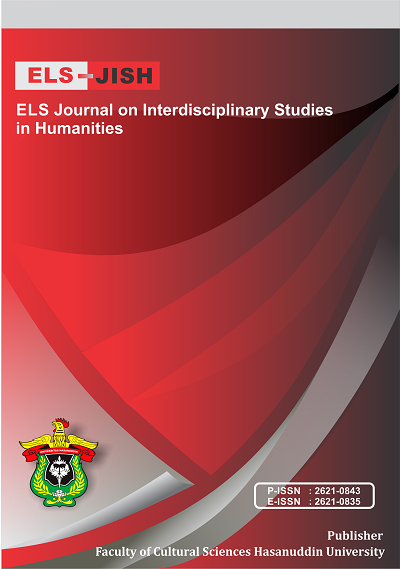Formation Rules for Indonesian Nouns Reduplication (Generative Morphology Review)
DOI:
https://doi.org/10.34050/elsjish.v6i2.27584Keywords:
Noun, Meaning, Morphology, Morphophonemic, ReduplicationAbstract
Morphology is a branch of linguistics that deals with the internal structure of words, and how it formed. This branch of linguistics has a very wide reach so that many aspects can be traced to obtain accurate information. Among these aspects is the aspect of forming Indonesian nouns. Although this aspect has been researched, there is still room for more interesting research. The aspect of formation of Indonesian nouns can still be further investigated by looking at a more specific aspect, namely the rules for forming reduplication nouns using a generative morphology review. This research aims to describe: (1) The process of forming Indonesian reduplicated nouns, (2) The rules for forming Indonesian reduplicated nouns, (3) The morphological and morphophonemic processes that occur in the formation of Indonesian reduplicated nouns, and (4) the original representation and birth representation in the formation of Indonesian reduplication nouns. So, this research attempts to formulate rules for forming reduplication nouns without being designed using statistical procedures. Therefore, this research used qualitative method. The population of this research is the competence of native Indonesian speakers as a whole. The analysis is carried out with a structured work step, which starts with identifying all duplicate Indonesian nouns. The identified reduplication nouns are then classified. The next work step is to formulate a set of rules for forming reduplication nouns. Through the results of the formulation, the original representation is obtained. After the initial representation has gone through a morphological or morphophonemic process as a filter, it arrives at the birth representation. The results of this research show that not all processes of forming reduplication nouns have to go through a filter. Reduplicated nouns that must pass through the filter are only those that are repeated in their entirety. This noun repeated in its entirety expresses the meaning of 'a lot of X'. The reduplication nouns that are not repeated in full must go through a filter to arrive at an acceptable form of reduplication nouns. The filter can be a morphomorphic process or a morphological process. In terms of meaning, apart from showing a plural meaning, there are also reduplication noun constructions that show a single meaning even though they have gone through a reduplication process.Downloads
References
Ampa, A. T., Basri, M., & Ramdayani, S. (2019). A Morphophonemic Analysis on the Affixation In the Indoensian Language. International Journal of Scientific & Technology Research, 8(7).
Andini, C., Yassi, A. H., & Sukmawaty. (2021). The Use of Honorifics in English and Buginese with special Reference to Bone Language: A Comparative Study. International Journal of Innovative Science and Research Technology, 6(7), 873-877.
Aini, N. (2014). Afiksasi, Reduplikasi, dan Komposisi Bahasa Jawa dalam Cerbung Getih Sri Panggung karya Kukuh S. Wibowo pada Majalah Panjebar Semangat Edisi 12 Bulan Maret Sampai Edisi 26 Bulan Juni Tahun 2013. ADITYA-Pendidikan Bahasa dan Sastra Jawa, 5(3), 8-14.
Borong, N. (2019). Morphological Variations of the Dialects in Western and Southern Leyte. Journal of Educational and Human Resource Development (JEHRD), 7, 41-53.
Bungatang, B. Makna Aspektualitas Afiksasi dan Reduplikasi pada Verba Bahasa Bugis. Retorika: Jurnal Bahasa, Sastra, dan Pengajarannya, 10(1), 256798.
Dwitama, I. M. K., Al Farisi, M. S., Alfina, I., & Dinakaramani, A. (2022, October). Building Morphological Analyzer for Informal Text in Indonesian. In 2022 International Conference on Advanced Computer Science and Information Systems (ICACSIS) (pp. 199-204). IEEE.
Ermanto, E. (2008). Hierarki Morfologi pada Verba Reduplikasi Bahasa Indonesia: Tinjauan dari Perspektif Morfologi Derivasi dan Infleksi. Humaniora, 20(1), 11920.
Ferawati, L. (2013). Analisis kontrastif reduplikasi bahasa Indonesia dan bahasa Jepang (Doctoral dissertation, Universitas Brawijaya).
Fox, A. (1995). Linguistic reconstruction: an introduction to theory and method. Oxford University Press, USA.
Ghanggo Ate, Y. (2021). Reduplication in Kodi: A paradigm function account. Word Structure, 14(3), 312-353.
Hasnia, H., Andini, C., Tahir, M. D., Hunaeni, H., Zulfikariandi, Z., & Muslimin, M. T. (2022). The Ability of 1st Class Students of SMAN 11 Enrekang to Arrange Verbal and Nominal Sentences. ELS Journal on Interdisciplinary Studies in Humanities, 5(3), 539-550.
Kaharuddin. (2003). Pembentukan Nomina Bahasa Indonesia (Tinjauan Morfologi Generatif). Tesis Pascasarjana Unhas, Makassar.
Karim, S., Mohd, F., Musa, H. B. H., Mahmood, A. H., Aman, M. S., Yunus, A. G., & Onn, F. M. (2016). Tatabahasa dewan. Dewan Bahasa dan Pustaka.
Keraf, G. (1999). Tata Bahasa Rujukan Indonesia. Gramedia Widiasar
Lehmann, C. (1992). Word order change by grammaticalization. Internal and external factors in syntactic change, 395-416.
Maniara, R. A. (2014). Reduplikasi Bahasa Inggris dan Bahasa Talaud (Suatu Analisis Kontrastif). Jurnal Elektronik Fakultas Sastra Universitas Sam Ratulangi, 3(2).
Moeliono, A. Dkk.(eds.). (1988). Tata Bahasa Baku Bahasa Indonesia (Edisi I). Jakarta: Balai Pustaka.(Cetakan pertama).
Omar, A. H. (2015). Kaedah penyelidikan bahasa di lapangan. Kuala Lumpur: Dewan Bahasa dan Pustaka.
Rahman, F., & Weda, S. (2019). Linguistic deviation and the rhetoric figures in Shakespeare’s selected plays. XLinguage" European Scientific Language Journal", 12(1), 37-52.
Rahman, F. (2018). The Constraints of Foreign Learners in Reading English Literary Works: A Case Study at Hasanuddin University. Journal of Arts and Humanities, 7(2), 01-12.
Simatupang, M. D. S. (2016). Reduplikasi morfemis bahasa Indonesia. Available at 2023. https://cir.nii.ac.jp/crid/1130282272818422272
Soebandi, L. (2013). Reduplikasi Nomina. s2pbsiunsurcianjur.ac.id/publikasi/34.../191, Available on 10 Januari 2023
Sukmawaty, Rahman, F. F. , & Andini, C. (2022). Covid-19 Pandemic and Axiology of Communication: A Study of Linguistic Phenomena. IJISRT, 7(4), 1079-1087.
Sudaryanto. (1992). Metode Linguistik: Ke arah Memahami Metode Linguistik. Yogyakarta: Gadjah Mada University Press.
Subroto, D. E., & Kunardi, H. (1992). Pengantar metoda penelitian linguistik struktural. Sebelas Maret University Press.
Tahir, M., Rahman, F., Rahman, A., & Pattu, M. A. (2021). Kajian Verba Resiprokal Dalam Naskah Boegineesche Chrestomathie. FIB Press.
Downloads
Published
How to Cite
Issue
Section
License
Copyright (c) 2023 Kaharuddin, M. Dalyan, Asriani Abbas, Munira Hasjim, Mardi Adi Armin

This work is licensed under a Creative Commons Attribution-ShareAlike 4.0 International License.

















